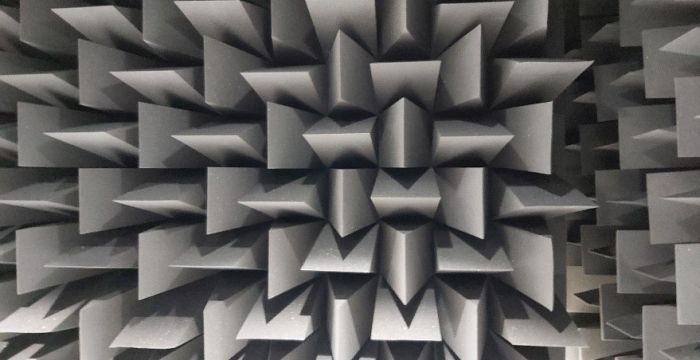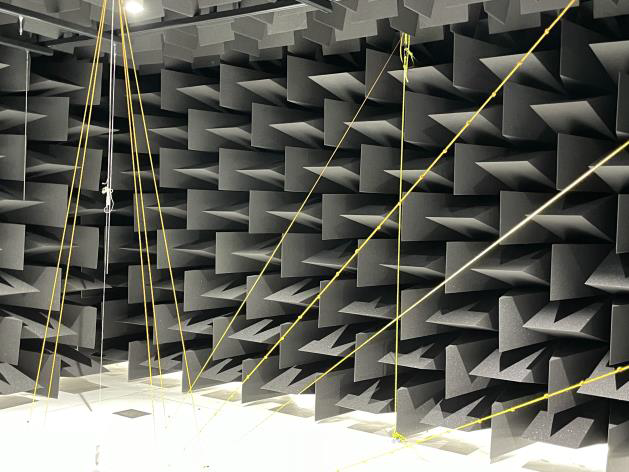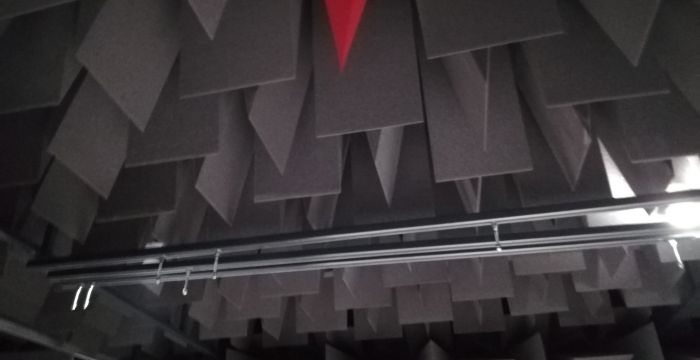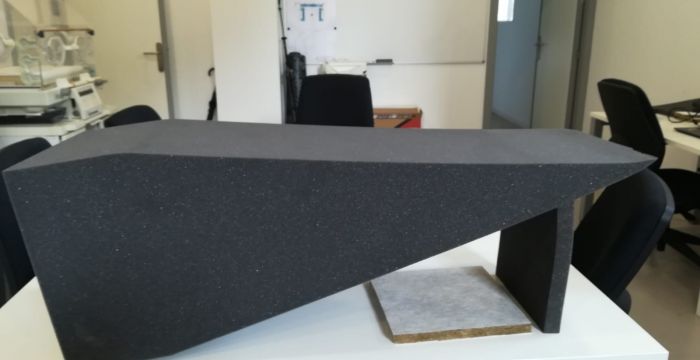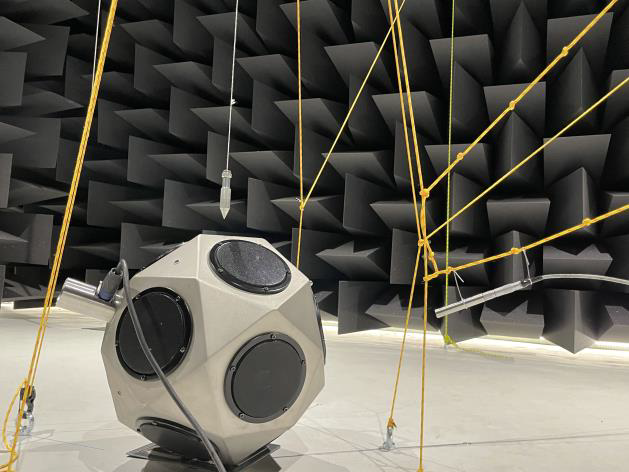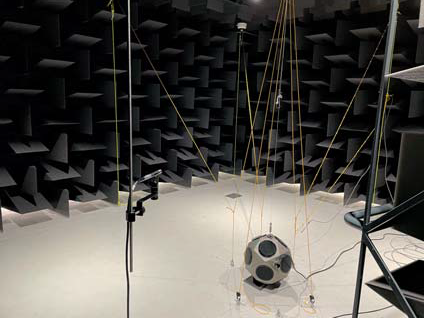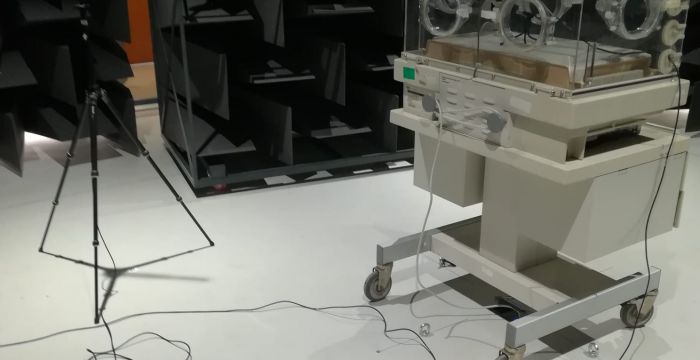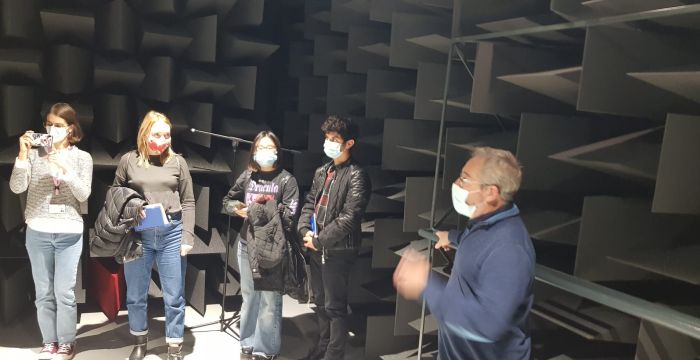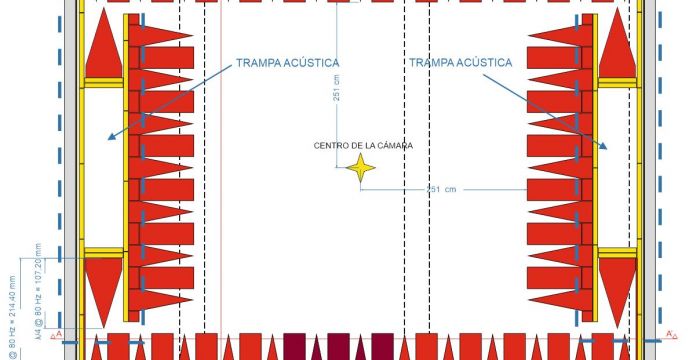Equipment of the Phonetics and Acoustic Engineering Lab
The Phonetics and Acoustic Engineering lab has the following equipment:
SEMI-ANECHOIC CHAMBER
The chamber is settled in the ground floor of Simón Bolívar Lecture Room and ESI-2 of the Campus of the University of Cadiz, situated in 18, Dr. Gómez Ulla Avenue in Cadiz.
DESCRIPTION OF THE CHAMBER
The chamber has the geometry of a cubic parallelepiped, with a free floor area of 5.02 x 5.02 (length x width), which gives it a usable area of 25.20 m2 defined between wedged points, and a height between the reflecting plane of the floor and the wedge point of the ceiling of 2.66 m. This assumes that you have a volume in that area of 69.6 m3. From the centre of the chamber on the ground to the tips of the wedges there is a minimum distance of 2.51 m and a maximum one to the ceiling of 2.76 m.
Regarding the construction elements and coating, the Cabin has:
Floating and reflective acoustic floor made of a double floating reinforce concrete slab supported by a combination of elastic and acoustic elements (mineral wool and impact sound insulation foil), trowelled, surfaced hardened with quartz, mechanically polished and lacquered with episodic resin paints. In addition, among them they have a mechanical sawing of the shrinkage joints to a width of 3 mm which desolarises them and absorbs the mechanical expansion stresses, treated with low hardness elastic PU resin, in order to achieve a concentric acoustic desolouration with respect to the portion of the floor on which the floating walls rest.
Floating walls and ceilings made of elastic metallic system (specific spring network to the system inertia), absolutely coated with a system of acoustic wedges of type Wedge made in flexible foam of fireproof polyurethane of 23 kg/m3 of density, of 335×335 mm of base, 167 mm of base height, and 1.000 mm of total height. The prescribed angle is 23º and the sound absorption area achieved per unit is 0.84 m2 per wedge unit (i.e.; 7.6 m2 of absorption are in 1 m2 of facing area of chamber; wall or ceiling). The cut-off frequency fc derived from this wedge dimension is 85 Hz. These wedges are counterpiped in order to increase the absorption surface to the different angles of incidence of the sound and pointing towards the centre of the enclosure.
Apart from the wedges, in the Chamber there are two acoustic elements in the two walls of less dimension of the Cabin that function as low-frequency floating traps tuned to 80Hz. These elements are made with sandwich panel separated of the wall to 550 mm, with a length of interior cavity and of ¼ wavelength input width of the frequency of 80 Hz, inside which are housed columns of a second type of wedges. These wedges (Figure 1 in the Image 1) are made with the same type of material of the other wedges, but due to its features it is made to work on the absorption of 80 frequency waves. Its dimensions are 550×550 mm of base, 179 mm of base height and 1.072 mm of total height. The angle is 34.2º and the area of acoustic absorption achieved per unit is 1.07 m2 per wedge unit.
Access door to the chamber consisting of a triple system:
Outside: Acoustic double leaf door, of 91 mm of thickness, composed by the frame and metal foil in polished plate of 1.5 mm of thickness filled with deadening materials, with an opening to the outside with a closing pressure, and a global index of acoustic reduction weighted A, RA of 52 Dba, that responds to the same acoustic isolation of the exterior dry-wall partition containing the chamber.
Middle area: Acoustic sliding door made continuously of the acoustic encapsulated tiled over the partition wall containing the chamber, with a global index of acoustic reduction weighted A, RA of 52 Dba.
Inside: metallic mobile cart of wedges Wedge of integer multiple dimension of inner chamber wedges required to form the chamber access shaft, which gives constructive, homogeneous and acoustic continuity to the inner lining of the chamber (wedges in dark red).
ACOUSTIC FEATURES
The chamber has been qualified according to the UNE-EN ISO Norm 3745:2012/A1:2017.
Concerning the acoustic isolation of the doors system of the chamber. As the chamber door is one of the constructive elements that composes the shared divisive between the corridor and the chamber itself, the level of isolation to air noise obtained in the AE2 test (between the corridor and the chamber) collects the value of the acoustic isolation of the door and, therefore, as it is supposedly the most fragile element of the composed, it can be ensured that at least the “door system” is constructed in such a way it has 71Dba.
Concerning the reverb time of the chamber. The reverb time values measured must be taken as the best possible approximation of the reverb existent time inside the chamber, since, due to the highly absorbent features of the semi-anechoic acoustic field achieved when reproducing inside, there are very short reverb times.
Concerning the level of noise at the background of the chamber. The levels of noise at the background measured are lower than the ones required by the Norm as absolute criteria of background noise evaluation against a rehearsal of acoustic potential. This implies that, in the practise of such Norm, the chamber enables to use the indicated criteria in the section 5.2.2 of the Norm.
Concerning the cut-off frequency fc defined by the size of the wedges. Once the results have been seen, the ranges of qualified frequency that starts from the 50 Hz frequency, so the chamber has a minimum cut-off frequency of 50 Hz. This value exceeds the of the design of geometry of the wedges, which respond geometrically to a fc of 85 Hz. This result can be due to two reasons: on the one hand, because each wedge is fixated to a deadening base of mineral wool, of 80 mm, that on the one hand they extend the “acoustic dimension of the wedge” and on the other hand, they introduce a higher density element and a great acoustic absorption in the wedge base; and, on the other hand, due to the absorbing effect that provides the acoustic traps made on both sides to the enclosure.
REVERBERANT CHAMBER
The most common use of the reverberant chambers is the collecting of the sound absorption ratio of materials, used to prepare or isolate properly an enclosure, according to its properties and use. Likewise, they are commonly used in order to obtain a sound potential level of a source, such as a speaker or a machine and to obtain the answer in transducers frequency.
Basically, its form is similar to an absolutely irregular trapezoid avoiding that none of their faces are parallel to each other, thus all of its vertexes have different angles. The chamber adjusts to what is indicated in the Norm UNE-EN ISO 354, even though its dimensions are lower than what is demanded for such type of chambers. The volume is 84.05 m3. The height to the forged is 4.548 m.
The access is made through a standard acoustic door. Complementing the irregular geometry of the chamber, flat diffusers of methacrylate of 20 mm of thickness are provided, with diverse trapezoidal forms and lengths between 1.75 m and 2 m and widths between 0.6 m and 1.30 m. The number, the distribution and the orientation have achieved following the usual art rules: values stability of the absorption ratio in the frequency from 100 Hz to 10 KHz.
The reverberation time hits the 3.28 for frequency of 315 Hz, being variable in function to the value of the frequency band considered.


